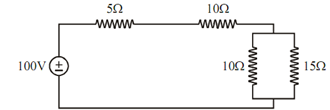Determine Potential Difference:
Compute the current through each element of the given network and also determine potential difference across 15 Ω resistor.

Figure
Solution
The circuit may be reduced in the following form :
Figure
Total current i in the circuit is achieved by
i = V/ R = 100 /(5 + 10 + 6) = 100 /21= 4.76 Amp
So the current through 5 Ω and 10 Ω resistor shall be i = 4.76 Amp.
Now, current through 10 Ω resistor in parallel branch is find out by current division rule :
i1 = i × (r2 / (r1 + r2))
= 4.76 × (15 / (10 + 15)) = 2.85 Amp
Likewise, current through 15 Ω resistor is
i2 = i × (10 / (r1 + r2))
= 4.76 × (10 /(10 + 15))
= 1.9 Amp
∴Potential difference across 15 Ω resistor shall be
V = i2 × 15= 1.9 × 15 = 28.5 volts